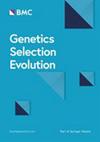在神经细胞的引导下,多种细胞类型协调了奶山羊角芽的形成
IF 3.1
1区 农林科学
Q1 AGRICULTURE, DAIRY & ANIMAL SCIENCE
引用次数: 0
摘要
角的发育是反刍动物通过分子途径进行多细胞协调的重要特征。本研究利用scRNA-seq分析了早期角芽生态位形成过程中的细胞异质性和命运轨迹,揭示了关键基因的表达谱。结合苏木精-伊红(HE)染色和免疫组化分析,进一步验证了诱导时胎羊角芽皮肤组织关键细胞的非同步发育途径(胚胎日(E) 50;E50)、器官发生(E60)和细胞分化(E70)阶段,并展示了早期角芽发育的信号传递途径。结合已有文献,揭示了牛角芽发育主要信号传递的时空差异。我们推测,在神经细胞的引导下,多种细胞类型协同作用于奶山羊角芽的形成。神经细胞接受最初的角芽信号,刺激毛囊细胞变性并传递给真皮细胞,真皮细胞通过中间体进化,将信号放大到上皮细胞,分化为间充质细胞。神经细胞分支也触发神经嵴细胞的产生/迁移,与软骨细胞一起促进角质细胞分化形成角芽。此外,我们进一步确定了早期角芽发育的特异性事件,包括生物学功能、信号通路和关键候选基因的筛选。本研究采用scRNA-seq技术表征山羊胎角芽细胞命运轨迹和基因表达谱。无角和有角胎儿的组织学比较揭示了上皮细胞、真皮细胞、神经细胞和毛囊细胞的异质性,假时间分析确定了不同的分化途径。免疫组织化学证实,真皮和上皮细胞的转录动力学对角芽形成(分支1)至关重要。角质细胞和神经细胞状态的转变积极调节角的发育,通过免疫组织化学观察到细胞的不同步发育。功能富集分析(GO/KEGG)突出了神经嵴发育和角质细胞分化途径,确定了参与角形态发生的候选基因(EGR1、ZEB2、SFRP2、KRT10、FMOD、CENPW、LDB1、TWIST1)。这些发现促进了对山羊角发育和遗传决定因素的理解。本文章由计算机程序翻译,如有差异,请以英文原文为准。
Multiple cell types guided by neurocytes orchestrate horn bud initiation in dairy goats
Horn development is a key ruminant trait involving multi-cell type coordination via molecular pathways. This study used scRNA-seq to analyze cellular heterogeneity and fate trajectories during early horn bud niche formation, revealing key gene expression profiles. Combining with hematoxylin–eosin (HE) staining and immunohistochemical analysis, we further verified the asynchronous developmental pathways of key cells in the skin tissue of fetal goat horn bud at induction (embryonic day (E) 50; E50), organogenesis (E60), and cytodifferentiation (E70) stages, and demonstrated the signal transmission routes for the development of early horn buds. We revealed temporal and spatial differences of the main signal transmission of horn bud development combining with existing literatures. We speculated that multiple cell types under the guidance of nerve cells collaborated on horn bud initiation in dairy goats. In detail, neural cells receive initial horn bud signals, stimulating hair follicle cell degeneration and transmitting to dermal cells, which evolve through intermediates, amplify signals to epithelial cells, and differentiate into mesenchymal cells. Nerve cell branches also trigger neural crest cell production/migration, working with chondrocytes to promote keratinocyte differentiation for horn bud formation. In addition, we further identified the early horn bud developmental specific events, including the screening of biological functions, signaling pathways and key candidate genes. This study employed scRNA-seq to characterize cell fate trajectories and gene expression profiles in goat fetal horn buds. Histological comparisons between hornless and horned fetuses revealed cellular heterogeneity in epithelial, dermal, nerve, and hair follicle cells, with pseudo-time analysis identifying distinct differentiation paths. Dermal and epithelial cell transcriptional dynamics were critical for horn bud initiation (branch 1), supported by immunohistochemistry. Keratinocyte and nerve cell state transitions actively regulated horn development, with asynchronous cell development visualized via immunohistochemistry. Functional enrichment analyses (GO/KEGG) highlighted neural crest development and keratinocyte differentiation pathways, identifying candidate genes (EGR1, ZEB2, SFRP2, KRT10, FMOD, CENPW, LDB1, TWIST1) involved in horn morphogenesis. These findings advance understanding of goat horn development and genetic determinants.
求助全文
通过发布文献求助,成功后即可免费获取论文全文。
去求助
来源期刊

Genetics Selection Evolution
生物-奶制品与动物科学
CiteScore
6.50
自引率
9.80%
发文量
74
审稿时长
1 months
期刊介绍:
Genetics Selection Evolution invites basic, applied and methodological content that will aid the current understanding and the utilization of genetic variability in domestic animal species. Although the focus is on domestic animal species, research on other species is invited if it contributes to the understanding of the use of genetic variability in domestic animals. Genetics Selection Evolution publishes results from all levels of study, from the gene to the quantitative trait, from the individual to the population, the breed or the species. Contributions concerning both the biological approach, from molecular genetics to quantitative genetics, as well as the mathematical approach, from population genetics to statistics, are welcome. Specific areas of interest include but are not limited to: gene and QTL identification, mapping and characterization, analysis of new phenotypes, high-throughput SNP data analysis, functional genomics, cytogenetics, genetic diversity of populations and breeds, genetic evaluation, applied and experimental selection, genomic selection, selection efficiency, and statistical methodology for the genetic analysis of phenotypes with quantitative and mixed inheritance.
 求助内容:
求助内容: 应助结果提醒方式:
应助结果提醒方式:


